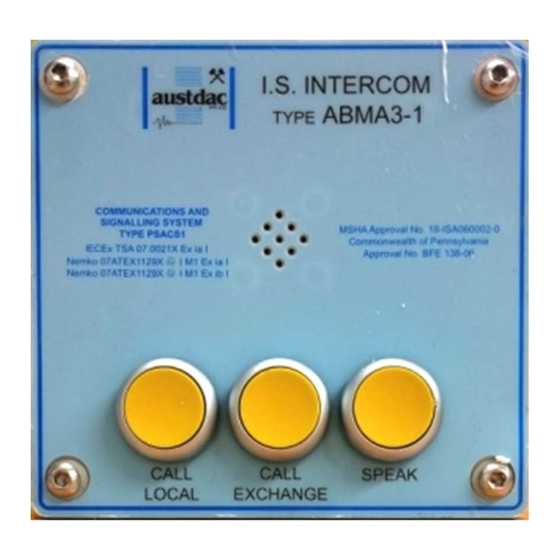
Table of Contents
Advertisement
Quick Links
Advertisement
Table of Contents

Summary of Contents for Austdac ABMA3-1
- Page 1 Title I.S. INTERCOM TYPE ABMA3-1 USER MANUAL Document Number 20-320-12 Issue...
-
Page 2: Table Of Contents
Copyright 2017 This document remains the property of Austdac Pty. Ltd. It is subject to its recall and must not be reproduced in part or whole or its contents divulged to third parties without prior written approval from Austdac Pty Ltd. -
Page 3: General Description
Photograph 1 below shows the front panel of a type ABMA3-1 intercom. Photograph 1: Intercom type ABMA3-1 front view. The intercom type ABMA3-1 has three front panel mounted push buttons, a front panel microphone and two side-mounted speakers to provide the voice communications interface for staff working along the conveyor belt. -
Page 4: Photograph 2: Intercom Type Abma3-1 Rear View
Photograph 2: Intercom type ABMA3-1 rear view The above photograph shows the rear of the ABMA3-1 intercom with its battery removed to expose the battery charge current select jumper. In the LO position the battery charge current is 11mA and 22mA in the HI position. -
Page 5: Operational Description
SPEAK key Pressing of the SPEAK key (a press to talk, ‘PTT’ action) the ABMA3-1 will turn off speakers and turn on the microphone. The unit will return to normal mode as soon as Speak key is release. -
Page 6: Certification
Figure 1: Simplified Un-Shielded Circuit If the shield is passed through from one cable to another between ABMA3-1 terminations and is not terminated at the R-Line then this is electrically noisier than having no shield at all. The coupling between shield and the V and S cores has the effect of giving alternative PSA signal paths that can cause the PSA Controller and ABMA3s to receive false confirmations on tail end units.

Need help?
Do you have a question about the ABMA3-1 and is the answer not in the manual?
Questions and answers